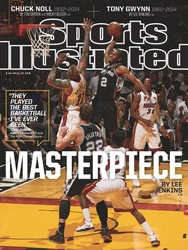
MEET THE NEW KING
Don't be fooled by the World Ranking. Comfortable at last with his revamped swing, Martin Kaymer lapped the field at the U.S. Open and stamped himself as the best player in the game today
PADRAIG HARRINGTON invokes the yin and the yang to explain his unending search. Tiger Woods's creed was, "If you're not getting better, you're getting worse." Trying to make sense of how he fell into one of the worst slumps in golf history, Ian Baker-Finch blamed his ambition, saying, "I felt I should contend in every major." It is the relentless, obsessive quest for self-improvement that can both make and break a champion. In 2010, Martin Kaymer won the PGA Championship at the age of 25, playing almost exclusively a Nicklausian fade off the tee. Six months later he summited the World Ranking. Naturally, this was the exact moment that Kaymer chose to blow up his swing, in search of a reliable draw. "He felt that as the No. 1 player in the world, he needed to be able to move the ball both ways," says Kaymer's manager, Johan Elliott.
"There is a correct and an incorrect way to play golf," explains Kaymer, the newly minted U.S. Open champion, more or less explaining his entire career. For him, improvement is not a goal, it's a lifestyle. A year and a half into his swing change Kaymer reached his nadir, shooting a 75 on an easy course in Portugal to miss the cut. "I remember it very clearly," says Phillip Kaymer, who last week shared a hotel room in Pinehurst with his kid brother. "He called and was very annoyed. He said, 'I'm working so hard, and the results are not coming.' But after two days his attitude was fine, and he was back to work."
Note that Kaymer's perilous fall from grace—he would bottom out at 61st in the world—led to exactly 48 hours of brooding, and then it was back to the grindstone. "It is the German way, no?" he says. But more enlightening is the timing of his funk—Portugal marked his return to competition following the 2012 Ryder Cup, where he summoned one of the gutsiest performances in recent golf history. Kaymer didn't make a single birdie during his opening four-ball match and was subsequently benched for all of Day 2. In singles Kaymer found himself in the defining match, against Steve Stricker. Somehow he found the belief and the will to pour in an eight-foot par putt on Medinah's 18th green to clinch the Cup. Most normal human beings would have pronounced themselves cured and spent the next month bathing in champagne and yet there was Kaymer two weeks later, grinding at a B-list Euro tour event. It was through these disparate moments that he built, brick-by-brick, the game and the competitive spirit that carried him to an utterly dominant victory last week at Pinehurst No. 2.
"Well, you know, it shouldn't sound cocky or arrogant, but I knew it would come," Kaymer said on Sunday evening following his eight-stroke victory over Rickie Fowler and Erik Compton, which made him the first man from Continental Europe to win the Open in the 114-year history of the event. "I knew that I would play good golf again. There was enough belief there. I just didn't think it would take me that much time to get back where I was or, actually, not where I was—I think I play better golf now. I'm more of a complete player. It was just a matter of time."
LAST WEEK Kaymer played like a man in a hurry to make history, as he all but ended the Open by lunchtime on Friday, opening with a dazzling pair of 65s. His two-round total was a tournament record, and his six-stroke lead matched the halfway advantage from two iconic performances: Woods at Pebble Beach in 2000 and Rory McIlroy at Congressional in '11. Kaymer's polished all-around game was on full display as he pounded long, controlled draws and fades off the tee (seventh for the week in driving distance and ninth in accuracy), attacked a fiddly setup with precise iron shots and tamed the tricky greens with a molten putter (third in the field with 110 putts, including just a single three-putt). "It was probably the best two rounds I've ever seen since I've been playing," said his shell-shocked playing partner Keegan Bradley.
As good as Kaymer was for the first two rounds, the tournament can be encapsulated by a pair of holes he played on Saturday. Already having made a soft bogey on the 2nd hole, he pulled his drive on the long par-4 4th into the trees. The ball settled into a nasty lie hard against an ankle-high clump of pine needles. Kaymer asked for a free drop but was denied. The final group on Open Saturday is chaos—a melee of media and USGA officials inside the ropes, overserved fans crowding all around, the air dense with humidity and pressure. It's easy to make a bad decision. Sam Snead would have tried to play a shot out of Kaymer's lie. So would Greg Norman and Phil Mickelson. None of those flighty megatalents has a U.S. Open trophy. Kaymer has no weaknesses in his game, but his greatest strength is his head. He had the wherewithal and the golf IQ to resist the temptation to be a hero. He accepted the penalty and took the drop. He punched out, hit an 8-iron to 18 feet and then buried the putt for the bogey that may have won the U.S. Open.
"Acceptance," said his caddie, Craig Connelly. "Sometimes bogeys are as good as pars at the U.S. Open." On the next hole Kaymer hit a sweet draw from the waste area to set up an eagle that defined the 72 that gave him a five-stroke lead.
The final-round test was more mental than physical. As Kaymer recounted afterward, "I was talking to my brother before I went out on the golf course. I said, 'How can I find the way to keep going? How do you do it from the inside like it's a true feeling?' A lot of people can say they want to play aggressive. But then somehow they hold back. You just have to do it. You have to convince yourself. You have to believe. You have to play brave." He toured the first six holes in one under par, ending any suspense, and yet Kaymer kept grinding until the end. He found particular satisfaction in the "great, high draw" with a 2-iron he played on the 16th hole. Kaymer's closing 69 was bettered by only three players among the top 20. In the history of the Open, his four-round total of 271 has been eclipsed only by McIlroy's 268, which was shot on a much more benign, rain-softened course.
WITH MCILROY'S off-course life as messy as Adam Scott's putting stroke, and Bubba Watson's ongoing unpredictability—he missed the cut at the Open—this is clearly Kaymer's moment. World No. 2 Henrik Stenson, who is still looking for his first major championship, was asked on Sunday how much better Kaymer can be. "I don't think he needs to be any better, does he?" Stenson said with a rueful chuckle. "He just needs to maintain." But of course that is not the Kaymer way. He will continue his brave search. But this time, don't expect him to lose his way.
"Well, you know, it shouldn't sound cocky or arrogant," Kaymer said, "but I knew it would come."
Of Kaymer's 65--65 start, Bradley said, "It was probably the best two rounds I've ever seen."
PHOTO
Photograph by Robert Beck Sports Illustrated
TACTICIAN Kaymer put on a clinic from tee to green, and the wire-to-wire winner was equally adept on and around No. 2's tricky putting surfaces.
PHOTO
Photograph by Robert Beck Sports Illustrated
KNOCK ON WOOD Fowler ran into tree trouble at the 4th on Sunday en route to a double bogey, but he rallied to tie for second.
PHOTO
AL TIELEMANS/SPORTS ILLUSTRATED
THE ONE Even after victories at the Players and the Open, Kaymer is ranked only 11th in the world. His play would suggest otherwise.

